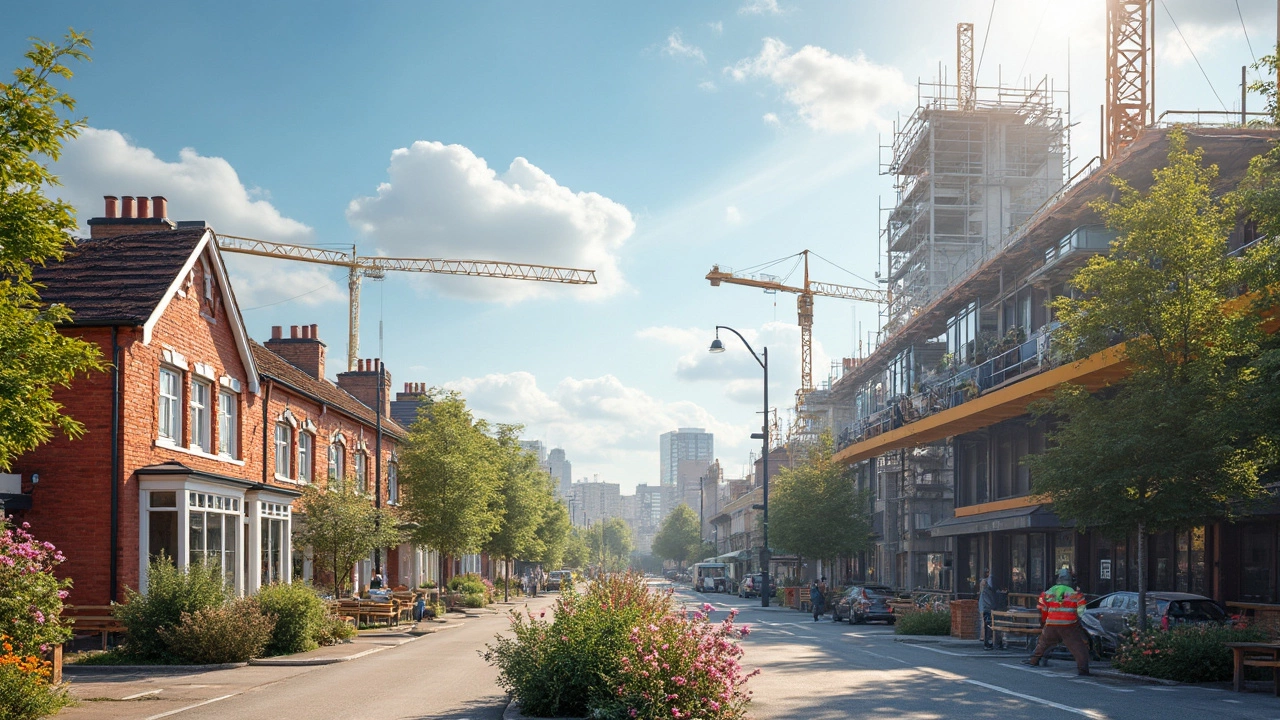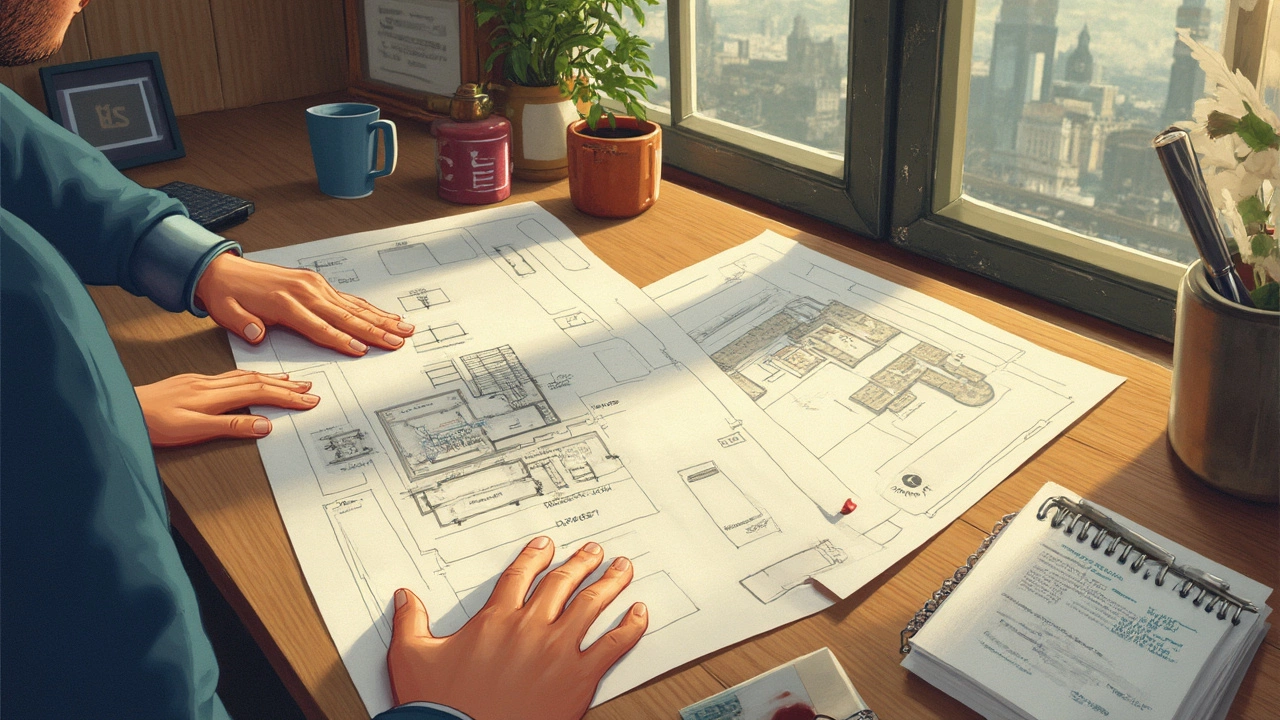Commercial vs Residential Construction Costs: What’s Really More Expensive?
 May, 30 2025
May, 30 2025
Ask anyone who's done both—putting up a commercial building almost always costs more than building a house. But the gap isn't just about size. The rules, the materials, even the team you need to hire all push up that price. And if you’re picturing just a bigger version of your living room, you might be surprised by how complicated things get when you’re dealing with office buildings or retail spaces.
If you’re just starting to compare, don’t focus only on the price per square foot. Commercial projects have way more hoops to jump through—think zoning rules, special permits, and endless inspections. The stuff you can get away with in a home just doesn’t fly in commercial setups. So before you start looking at bids, let’s break down what really makes commercial construction the pricier option—and where you have a little wiggle room to save.
- The Basics: What Sets Commercial and Residential Apart?
- Digging Into the Numbers: Why Commercial Gets Costly
- Hidden Costs Many Don’t See Coming
- Smart Ways to Manage Construction Budgets
The Basics: What Sets Commercial and Residential Apart?
First, let’s clear up one thing: commercial construction and residential building are a world apart. Most folks think it just means building bigger, but that misses the mark. The whole setup changes, from the ground up. Commercial projects cover stuff like retail stores, offices, warehouses, and restaurants. Residential is your home turf—houses, condos, and apartment buildings where folks live.
Why does this matter so much for costs? The main reason: rules. Commercial jobs have way more regulations. You’re dealing with stricter safety codes, different fire and electrical systems, and tougher accessibility rules. For example, the Americans with Disabilities Act (ADA) applies to commercial buildings but not to most homes. That means ramps, elevators, wider doors—every one of those adds dollars to your project.
The timeline also changes. Commercial builds usually have to go through longer city approval processes and special inspections. You don’t just get your cousin with a pickup to wire the lights—certified pros are a must, and that ups labor costs. That’s a whole different ballgame from hiring a handyman for a home remodel.
The materials are another story. Commercial projects use steel framing, concrete panels, and high-grade HVAC systems that are built to last and handle heavy use. Residential homes usually stick with wood framing and standard plumbing, which is just cheaper all around. On top of that, a commercial building’s systems—fire suppression, security, climate control—are way more complex and pricey.
So when you see a commercial construction quote that seems sky-high, now you’ll know why. You’re not just paying for extra square footage; you’re covering a mountain of extra regulations, professional fees, upgraded materials, and time. It’s not just bigger. It’s a totally different animal.
Digging Into the Numbers: Why Commercial Gets Costly
Here’s the truth: commercial construction almost always ends up with a much higher bill than residential projects. We’re not just talking a few bucks. Think double or even triple the cost per square foot, depending on what you’re building and where. For example, the national average cost per square foot for a basic commercial office building in the U.S. sits between $200 and $400. Meanwhile, a new mid-range single-family home lands closer to $120 to $180 per square foot. Fancy offices, hotels, or hospitals? That number shoots past $500 quick.
The main driver behind these higher numbers is the set of building codes and safety regulations commercial projects face. You simply can’t cut corners. Want an elevator, a commercial-grade fire suppression system, ADA-compliant restrooms, and energy-efficient HVAC? You’re paying for every bit of that. Then there’s the insurance—commercial insurance runs much higher, since liability risks are steeper when the public is involved.
Check out the numbers:
| Type | Cost Per Sq. Ft. (2024 Avg.) |
|---|---|
| Residential Home | $120 - $180 |
| Office Building | $200 - $400 |
| Retail (Shell) | $160 - $350 |
| Hospital | $450 - $700 |
Materials used in commercial construction projects usually have to be stronger and last longer than what you’d use at home. For example, commercial floors are made to handle hundreds or thousands of people, heavy equipment, or even vehicle traffic (think parking garages). An average office job will include steel framing, concrete flooring, high-performance glass, sprinkler systems, and soundproofing—none of which show up in a basic house build.
Another thing that drives up cost is the team. You don't just need a general contractor; you need engineers, a commercial architect, specialty subcontractors, and a project manager. Each box on the org chart means more zeroes on that final bill. Labor costs for commercial contractors are also higher. These professionals often have extra certifications and bigger crews who must work within strict timelines.
Here's what usually makes commercial costs stack up faster:
- Complex design (elevators, multiple floors, security systems)
- Specialty permits and compliance (fire code, ADA, environmental)
- High-performance materials (steel, tempered glass, advanced HVAC)
- Insurance and bonds for large projects
- Specialist labor and project management
If you're thinking about taking on a commercial build, know these numbers aren't going down any time soon. Material prices, labor shortages, and stricter regulations mean you’ll want to budget with a cushion—no one likes surprises halfway through the project.

Hidden Costs Many Don’t See Coming
The sticker price for commercial construction only tells half the story. There are a lot of things that sneak up on you, especially if you’re used to building houses. These surprise costs can blow up your budget fast if you don’t spot them early. Let’s look at some of the big ones most folks miss.
- Permitting and Inspections: You’ll shell out way more for commercial permits compared to residential. Some cities want separate permits for fire safety, plumbing, and electrical work. Inspections can drag on, during which your crew might be stuck waiting—costing you in both time and money.
- Utility Upgrades: Commercial buildings need beefier power, water, and sewer systems. Even if there’s an existing line, new codes can force you to upgrade. Hooking up a restaurant kitchen or a medical office isn’t the same as wiring a home kitchen. Budget in thousands extra just for utility work.
- Insurance and Liability: Commercial projects carry bigger risks. You’ll need general liability insurance, property insurance, and probably workers comp for everyone on site. Premiums can be 2-3 times higher than what you’d pay for a home build.
- Change Orders: Every time you tweak the plan—even minor stuff—expect extra charges. Commercial contracts often have language letting contractors bump up the bill, especially if material prices jump or there are design tweaks after sign-off.
- Specialty Equipment and Safety: Commercial laws demand features most houses don’t: elevators, sprinkler systems, ADA accessibility stuff like ramps and bathrooms, and sometimes even earthquake or hurricane proofing. These don’t just mean buying gear—they mean hiring the right experts to install and approve them.
Here’s a quick comparison of typical hidden costs you’ll see in commercial projects versus residential:
| Cost Type | Typical Residential | Typical Commercial |
|---|---|---|
| Permitting & Fees | $5,000 - $15,000 | $30,000 - $100,000 |
| Utility Upgrades | $3,000 - $10,000 | $20,000 - $70,000 |
| Insurance | $2,000 - $5,000 | $10,000 - $30,000 |
| Accessibility Compliance | N/A | $15,000 - $70,000 |
The best tip? Always build in a buffer—at least 10% of your total budget—for these hidden costs. Contractors, especially the experienced ones, will tell you that something unexpected always comes up. If you get lucky and don’t need the extra cash, great. But if a surprise hits you mid-project, you’ll be glad you planned ahead.
Smart Ways to Manage Construction Budgets
If you’re not watching every detail, a commercial build can eat up your budget before you lay the foundation. So how do you keep things on track and avoid nasty surprises? Here’s what works in the real world, not just on paper.
One of the biggest things people miss is getting granular with their planning. The best budget is the one you review over and over with your builder and your project manager—not just at the start, but every single step. No joke, a 2023 U.S. construction industry report found that projects with weekly budget check-ins ran 22% less over budget than those reviewed just once a month. That’s a game-changer for keeping costs down.
Another tip: Don’t overlook the bidding process. Too many owners just pick the lowest bidder, but cheap up front often means expensive headaches later. Make bidders show detailed breakdowns—labor, materials, timeline, even how they’ll handle delays. When my wife Natalie and I oversaw a small strip mall build, the contractor who seemed priciest actually laid out exactly where every dollar was going. We could see they’d built in spare change for the "unknowns" (which always pop up), and it saved us a ton of stress later.
- Get realistic with contingencies. Build in at least 10% extra for commercial projects. Every seasoned builder knows something unplanned will come up—it’s just a matter of what and when.
- Phase your project. Not everything needs to happen at once. Sometimes it’s smarter to finish critical areas first, move tenants in, and finish extras as the cash flow improves.
- Value engineering isn’t just a buzzword. Work with your design team to swap in materials or layouts that do the same job for less money, without killing quality or safety.
- Stay on top of paperwork. Permits and inspections can trigger delays if you slip up. Those delays rack up costs through idle crews or equipment sitting unused.
Take a look at how fast overruns can add up if you’re not careful:
| Common Budget Breaker | Average Extra Cost (USA, 2024) |
|---|---|
| Design Changes After Approval | $8,500+ |
| Permit Delays | $1,000/week |
| Unclear Scope | 5-10% of total project |
| Poor Bid Selection | Varies, but often 15% over initial estimate |
Last tip—keep all your receipts, change orders, and invoices organized. Digital tools like Procore and Buildertrend can save your sanity by tracking every penny. And remember, staying commercial construction savvy means less financial pain from start to finish.
